Back when I was a thirteen-year-old regular at my local used bookstore I discovered the novels of John D. MacDonald, those beat-up little paperbacks with lurid covers and great titles. Over the years I’ve grown to love MacDonald’s standalone thrillers, some of which are true pulp classics, but as a young bookworm I was obsessed with the Travis McGee series, easily identifiable because the titles all included a color. Finding one of those meant you were set for a great afternoon of reading, plunked down into seamy, seedy Florida in the 1960s with one of the best detective heroes ever written.
Travis (Trav to his friends) McGee is a wiry, knuckly, very tan, very tall boat bum who lives on a house boat in Fort Lauderdale (Slip F18, Bahia Mar). When he has enough money he is retired, working on his boat, drinking Plymouth gin, talking philosophy with his best friend Meyer, bedding a string of women. When he needs money, he is a salvage consultant. Meaning that if you’ve lost something, he’ll get it back and take fifty percent of its worth. He has no office, and no business cards. Word just gets around.
I suspect there are two hard-core groups of Travis McGee devotees: there are his first fans, the men and women (let’s face it, probably more men) who bought the original paperbacks and fell in love with this strange and compelling protagonist. The second group of fans are those slightly younger men and women (probably more men) who found these books on their father’s bookshelf, or, like me, in the local used book store, or paperback rack at the library.
One thing is sure: the quality of these books is pretty damn consistent. If you like one of them, you’ll probably like all of them. That made ranking them less than ideal. I was pretty sure about my favorites, and my least favorites, but it gets a little slapdash in the middle. When ranking, I thought about the flow of the story, the scariness of the bad guy, the complexity (or lack) of the heroine, and the quality of the writing (always very high). What I didn’t think about while ranking was the casual sexism and racism that pervades these books, and that I see more as an expression of the time than what seems like any real hostility or agenda on the author’s part.
Travis loves women, and there are some good, strong female characters in these books. But Travis also loves to save a damaged damsel, so that many of the females that show up are victims for Travis to put back together. He is a white knight, a man beholden to no one, constantly swept up into great adventures, and into the arms of fascinating bedmates. In other words, a male fantasy.
I realized, even as a young reader, that these books were escapist entertainments. They offer a respite from the worries of life, and a step back in time to a very different America. And in that spirit was how I went about crafting this list. The very best of the Travis McGee novels turn off that part of the brain that is wondering how you’ll pay the bills, or what to make for dinner, or what the world will be like in five years. And they do it in high style, with great writing, some real surprises, and some brutal truth-telling.
Oh, and one last thing. It all seems a little grubby, this whole ranking business. So all I want to say is that if you like spending time with Travis McGee, and Meyer, and all the other quirky, hard-partying residents of Bahia Mar, then read all the books. You won’t be disappointed.

#21
One Fearful Yellow Eye (1966)
This one feels as though Travis McGee was inserted into a story idea that was never intended to have him in it. The setting is Chicago in wintertime and the storyline is a family drama centered around an extortion plot. It’s short on cleverness, and McGee, in a foul mood for most of the book, comes across as a bit of a bully. Even when the plotline returns him to Florida, the book never quite corrects course, and the resolution requires the worst kind of deus ex machina ending.
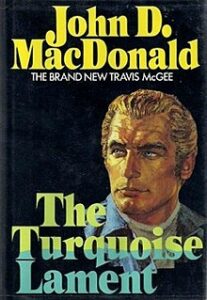
#20
The Turquoise Lament (1973)
It’s got all the hallmarks of a classic Travis McGee story. Lots of Meyer, lots of philosophizing, a lovely young woman with an odd/cutesy name (Pidge), a psychopathic villain, financial shenanigans. It’s even got some classic sunken treasure hunting, plus it globe-trots, putting McGee in Hawaii and American Samoa among other places. Despite all this, this book has always felt flat to me, the various elements never gelling into a propulsive story. In between the action, the book sags.
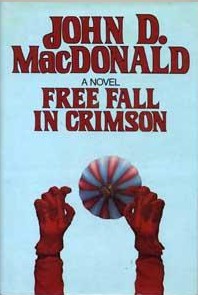
#19
Free Fall in Crimson (1981)
There’s a novelty quality to this one: McGee learns how to pilot a hot air balloon, then takes on the biker crowd; he even gets temporarily adopted by one of the gangs. It doesn’t quite work for me, especially after the brilliance of The Green Ripper. There’s not a lot of immediacy to it. The villain is scary but he comes on too late, and while there are some exciting action scenes set around the world of ballooning, it all seems a little too heavily researched. It’s as though MacDonald took a balloon ride, fell in love with it, and built a book around the experience. The saving grace of this novel is a terrifying ending where we get to see another side of Meyer.

#18
The Empty Copper Sea (1978)
After basically writing at least one McGee adventure per year since the early 1960s, MacDonald took a four-year break before penning his last four novels, beginning with this one. There’s a change in mood in these last books. It’s noticeable here, with Travis a little more weary, a little more depressed. It somehow feels very late seventies, with references to Star Wars, Billy Carter, and a long rumination on the “sympathy fuck.” While I like these late books, this one doesn’t quite do it for me. Travis is never part of the action of the novel, with its plot involving a businessman who has cashed out his investments and disappeared. Meyer does the heavy lifting while Travis mopes, then falls in love in a way that feels more narratively convenient than real.

#17
Dress Her in Indigo (1969)
Set almost entirely in Oaxaca, Mexico, Travis and Meyer are trying to find out what caused the death of a friend’s daughter. Part travelogue and part cautionary tale (think Reefer Madness), this book does deliver some very twisted villainous types, and the characterization of the hippy/druggy scene in Mexico is quite lurid, as well. What lets it down is maybe the most cardboard of all the McGee girlfriends, a Mexican beauty named Elena.
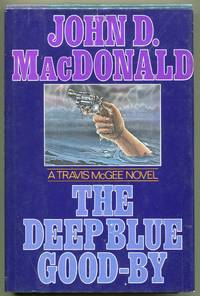
#16
The Deep Blue Good-by (1964)
Travis McGee is pretty much Travis McGee in the first book in the series. Maybe a little more rough around the edges, a little more mercenary. Junior Allen is the villain, and he’s a tad underdrawn but no less scary for it. A psychotic who has left a string of broken women in his wake, Travis tracks him down to recover a bag of stolen jewels. Great, brutal action at the end, and a real melancholy feel in the coda.
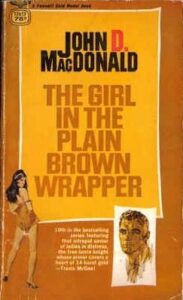
#15
The Girl in the Plain Brown Wrapper (1968)
A solid entry. The opening third is terrific, setting up a backstory that will eventually send McGee to check in on the sick daughter of a dead friend. Then we get a rather sinister psychological thriller that doesn’t quite nail the ending. Two points, and I know I said I wasn’t going to discuss this, but as any regular reader of MacDonald knows, the sex scenes are a little lengthy and a little over-described, and this book contains maybe the worst of those excesses. But it also contains a black maid character that is beautifully written and makes you long for a little more diversity in these books. Or not, considering some of the outdated attitudes. Just sayin’.
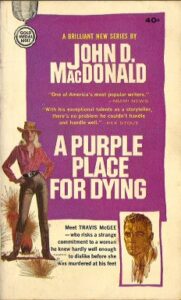
#14
A Purple Place for Dying (1964)
I love the first half of this novel. The opening chapter is incredibly strong, with a vicious surprise. It’s set in the southwest and a lot of the hallmarks of a classic McGee novel are missing. No Meyer, nothing set in Florida. More good ol’ boy rich men, redneck sheriffs, and Mexican spitfires. The villain is hidden until the end, and it’s not one of MacDonald’s great reveals, coming out of left field, or at least it did for me. The love interest, like the rest of the book, starts off interesting but diminishes by the end.

#13
Pale Gray for Guilt (1968)
A strong start to this book, in which McGee loses a close friend to a bevy of shark-like land developers. McGee and Meyer concoct a long con in order to get revenge. There are nice moments along the way, including a rather interesting girlfriend named Puss Killian, and a McGee rumination on the passage of time that is one of the finest moments of philosophy the series produced. But the con is a little too complex, and the plot loses its momentum, making for some less than enthralling reading. Like pretty much all the books in the series, however, MacDonald sticks the landing with a melancholy last chapter.

#12
Nightmare in Pink (1964)
For the second book in the series, it’s interesting how much of an outlier this one is. No Busted Flush until the very end, no Meyer yet, and Travis spends the bulk of the novel in New York City, helping out the sister of a friend who lost a fiancée in suspicious circumstances. It’s a great little detective story that takes a huge left turn into quasi-sci-fi territory when Travis gets kidnapped and imprisoned in a mental hospital that is experimenting on its patients. Strange stuff, but a really compelling read, and there are a few real classic McGee monologues, including one about poodles in New York City that made me laugh out loud.

#11
Darker than Amber (1966)
Famous for its opening scene, in which Travis and Meyer are fishing under a bridge at midnight when a woman with cement blocks wired to her feet comes crashing down on them. I think this is a solid adventure story with some truly wicked characters. There are also some nice surprises in regard to the damsel, who is a lot less distressed than you’d think. The book flounders a little in the middle, and the end is satisfying but a little all over the place. This one was actually made into a feature film starring Rod Taylor as Travis McGee. It’s not particularly good, but well worth finding if you’re a fan.
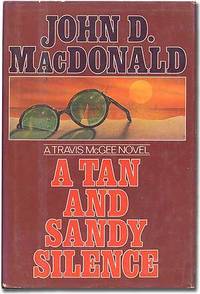
#10
A Tan and Sandy Silence (1971)
Plenty to like in this one, but there’s also some filler, as though the story—McGee tracks down an old girlfriend who’s gone missing—wasn’t quite enough for a book-length story. The filler includes a subplot in which McGee is considering becoming the permanent boyfriend of a rich, yachting lady, and there’s not a whole lot of suspense there, since readers know it will never happen. There’s a great sequence set on the island of Grenada, though, where McGee incorporates himself into a situation that turns extremely violent. Lots of Meyer in this one, as well.
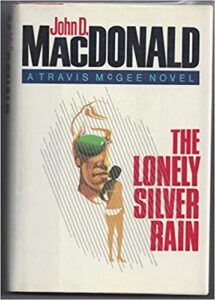
#9
The Lonely Silver Rain (1985)
While this wasn’t written intentionally as the finale of the series, it certainly works as a lovely gracenote. There are two things happening in this book. The first is that Travis finds a stolen boat for a friend (a brilliant opening few chapters) then winds up on a hit list, caught between South American drug dealers and American mafia-types. While this plotline seems somewhat apropos to the 1980s, it strikes a slightly discordant tone for me, and it puts McGee on his backfoot, mainly reacting to what’s around him. But there’s another part of the story, and all I’ll say about it is that it involves a mysterious visitor to the Busted Flush, who leaves behind pipe cleaner cats in different colors. The resolution of that story is quite sweet, as an older Travis discovers his world is bigger than he thought.

#8
The Quick Red Fox (1964)
A pretty terrific jet-setting adventure. McGee is hired by an A-list movie star to find out who’s blackmailing her with pictures of a group-sex weekend romp. What works really well in this book is that Lysa Dean, the movie star, assigns her executive assistant, Dana Holtzer, to shadow McGee as he tracks down the varying members of the swinging weekend. They make a good odd couple, and the story moves fast toward a startling ending. Dana is one of the more complex of the McGee girls, and her bitterness matches the book’s.
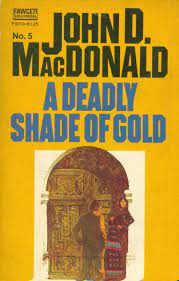
#7
A Deadly Shade of Gold (1965)
Maybe the only book in the series that you could call epic. It spans four locations, including New York City, a Mexican resort town, and some swinging parties in Los Angeles. There are several excellent, violent action set pieces, and Travis has five separate flings. All of this goes down as he’s tracking down a slew of missing gold statues and the killer of his old friend Sam Taggart, who’d been in possession of the gold at one point. This one’s right up there, dark and bloody and thrilling, and if the plot gets a little complicated—there are many, many balls in the air in this one—it’s still a great ride.
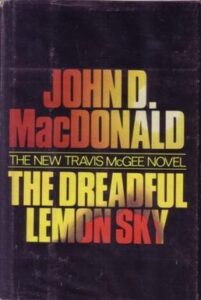
#6
The Dreadful Lemon Sky (1974)
There’s a good detective story underpinning the usual shenanigans in this novel, as Travis and Meyer travel to a small bay town to find out what happened to one of McGee’s old girlfriend after she left him a hefty package of cash to protect. There’s a classic noir feel in that everyone they meet seems suspicious and sleazy, but it all holds together well once the full tale is revealed. There’s a great fight, a Meyer monologue on the nature of death, a few wily villains, and it all moves faster than a hooked billfish.

#5
Bright Orange for the Shroud (1965)
Short, and with very little fat on it, this is the first McGee novel that really delves into the specifics of a financial con game. MacDonald, with his degree in business, made fruitful use of financial shenanigans in a number of his books, and he’s truly brilliant at it. He even wrote a couple of standalones that could be classified simply as business thrillers. In this one, an old friend of McGee’s shows up out of the blue (standard practice in Bahia Mar) having been stripped of every cent by a predatory wife. McGee unravels the con through a series of clever detective set-pieces, then ends up battling one of the scarier villains in the series, a psychopath named Boone Waxwell (I pictured a 1970s Burt Reynold in the role). A great book, notable, also, because McGee somehow goes from start to finish without a romantic entanglement.
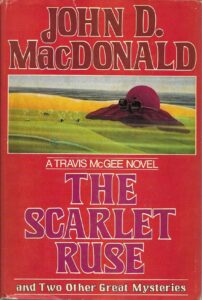
#4
The Scarlet Ruse (1973)
Most McGee books are fast balls or change-ups, but in this case, MacDonald delivers a bit of a curveball. What starts with Meyer talking McGee into investigating a scam that involves some very expensive stamps transforms into a psychological thriller with a rather good sociopathic villain. There’s a real sadness to this book, and a lovely passage where McGee ruminates that he feels outside of the world looking in (Meyer’s response: “But we are all like that … Didn’t you know?”). I am also very fond of Mary Alice McDermit, McGee’s love interest in this one.

#3
The Long Lavender Look (1970)
Hardboiled McGee, as he gets caught up in the aftermath of a bank heist, one in which the principal actors are killing each other off. This book starts fast, with Travis and Meyer returning from a wedding and winding up in ten feet of swamp water after nearly hitting a woman running across the road. Within two chapters they are both arrested for murder. There’s lots of great detective work in this book, and some dark surprises. Good stuff.

#2
Cinnamon Skin (1982)
Late McGee, and a haunting, mournful book. Meyer is still reeling from the events of Free Fall in Crimson, and then his niece and her husband are blown up in his houseboat, the John Maynard Keynes. Together, McGee and Meyer travel the country trying to piece together what happened and discovering that they are on the track of a devious serial killer. It’s a ruminative book that is never remotely slow, and the writing is top-notch, filled with astute descriptions of a changing American landscape. I’d almost put this book at the top of this list, but as good as it is, it doesn’t quite stick the landing.
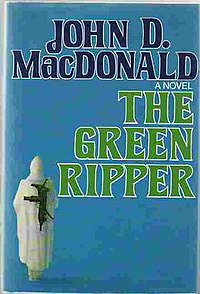
#1
The Green Ripper (1979)
The only really controversial McGee book, and one that is either your favorite or your least favorite. Obviously, considering its placement on the list, you can tell where I stand. What makes this one an outlier (a brilliant outlier) is that McGee, after losing the woman he hopes to spend the rest of his life with, goes on a revenge killing spree, targeting a religious cult with terrorist aspirations. The second half is pure action, playing out more like First Blood than the usual gin-and sun-soaked adventures of McGee and Meyer, but the first half does have plenty of Bahia Mar and Meyer and some real intrigue as McGee tries to figure out how the woman of his life mysteriously died. Why do I love it? Because it’s perfectly written without an ounce of fat on it, and because it pays off the entire arc of Travis McGee up to that point: There is only so much death one man can take before he starts to dole it out himself.

















